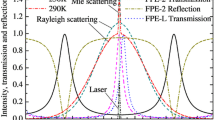Abstract
Atmospheric changes in the lower troposphere have been remotely studied using a self-engineered Mie scattering lidar with special emphasis on aerosols and clouds profiling over Islamabad region in Pakistan. The lidar is based on a Nd:YAG laser operating at 1064 nm, with maximal energy of 350 mJ at 20-Hz repetition rate and 5-ns pulse length. A silicon avalanche photodiode (Si-APD, C30950E) module is used as a detector. A higher resolution of the lidar revealed time evolution of thermal transport phenomena in the convective boundary layer. Regions of incessant wind speed, temperature, and particulates concentration have been detected through band-like structures at altitudes above 900 m. Strong backscattering (β) and extinction (α) due to a partially invisible thin cloud layer falling in the field-of-view of the lidar beyond 4 km have been identified.
Similar content being viewed by others
References
Y. J. Kaufman, D. Tanre, and O. Boucher, “A satellite view of aerosols in climate system,” Nature 419, 215–219 (2002).
A. J. Pope, R. T. Burnett, M. J. Thun, E. E. Calle, D. Krewski Kazuhikoto, and G. D. Thurston, “Lung cancer, cardiopulmonary and long term exposure to fine particulates air pollution,” J. Am. Med. Assoc. 287 (9), 1132–1141 (2002). doi 287.9.1132
A. I. Grishin and A. V. Kryuchkov, “Lidar observations of atmospheric optical characteristics during Sichuan earthquake,” Atmos. Ocean. Opt. 3 (31), 269–272 (2018).
F. G. Fernald, B. M. Herman, and J. A. Reagan, “Determination of aerosols height distribution by lidar,” J. Appl. Meteorol. 11, 483–484 (1972).
J. D. Klett, “Lidar inversion with variable backscatter and extinction ratios,” Appl. Opt. 24 (11), 1638–1639 (1985).
J. D. Klett, “Stable analytical inversion solution for processing lidar returns,” Appl. Opt. 20 (2), 211–212 (1981).
K. Sassen and R. L. Petrilla, “Lidar depolarization from multiple scattering in marine stratus clouds,” Appl. Opt. 25 (9), 1450–1459 (1986).
S. A. Young, “Analysis of lidar back scatter profiles in optically thin clouds,” Appl. Opt. 34 (30), 7019–7022 (1995).
V.A. Kovalev and W.E. Eichinger, Elastic Lidar: Theory, Practice and Analysis methods (Wiley, Hoboken NJ, 2004).
C. Weitkamp, Lidar Range Resolved Optical Remote Sensing of the Atmosphere (Springer, 2005).
Ruangrungrote, “Modelling of aerosol parameters retrieval algorithm based on Mie scattering lidar,” APRA KMITL. Sci. Tech. J. 1 (10) (2010).
H. Li, Y. Yang, X. Hu, Z. Huang, G. Wang, and B. T. Zhang, “Evaluation of retrieval methods of daytime convective boundary layer height based on lidar data,” J. Geophys. Res. 122 (8), 4578–4593 (2017).
M. Mao, W. Jiang, J. Gu, C. Xie, and J. Zhou, “Study on mixed layer, entrainment zone and cloud feedback based on lidar exploration of Nanjing city,” J. Geophys. Res. Lett. 36, L04808 (2009).
G. P. Kokhanenko, Yu. S. Balin, M. G. Klemasheva, I. E. Penner, S. V. Samoilova, S. A. Terpugova, V. A. Banakh, I. N. Smalikho, A. V. Falits, T. M. Rasskazchikova, P. N. Antokhin, M. Yu. Arshinov, B.D. Belan, and S. B. Belan, “Structure of aerosol fields of atmospheric boundary layer according to aerosol and Doppler lidar data during passage of atmospheric fronts,” Atmos. Ocean. Opt. 1 (36), 18–32 (2017).
F. G. Fernald, “Analysis of atmospheric lidar observations: Some comments,” Appl. Opt. 23 (5), 652–653 (1984).
M. Posyniak, T. Stacewicz, M. Miernecki, A. K. Jagodnicka, and S. P. Malinowski, “Multiwavelength micro pulse lidar for atmosphere aerosol investigation,” Optica Applicata 40 (3), 623–632 (2010).
Author information
Authors and Affiliations
Corresponding author
Additional information
The article is published in the original.
Rights and permissions
About this article
Cite this article
Raza, G., Ashraf, M.A., Qureshi, S.H. et al. Remote Sensing of Lower Tropospheric Aerosols and Clouds over Islamabad Region Using a Self-Engineered Mie Scattering Lidar. Atmos Ocean Opt 31, 650–655 (2018). https://doi.org/10.1134/S1024856018060222
Received:
Published:
Issue Date:
DOI: https://doi.org/10.1134/S1024856018060222




